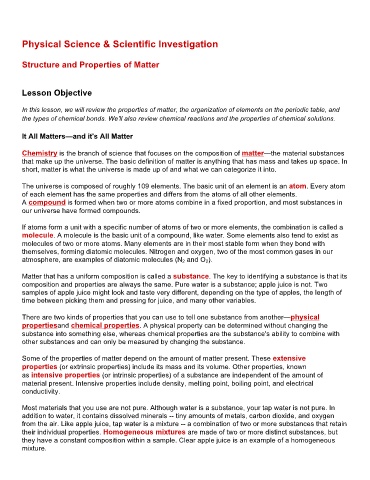Page 331 - ABCTE Study Guide_Neat
P. 331
Physical Science & Scientific Investigation!
Structure and Properties of Matter
Lesson Objective
In this lesson, we will review the properties of matter, the organization of elements on the periodic table, and
the types of chemical bonds. We'll also review chemical reactions and the properties of chemical solutions.
It All Matters—and it's All Matter
Chemistry is the branch of science that focuses on the composition of matter—the material substances
that make up the universe. The basic definition of matter is anything that has mass and takes up space. In
short, matter is what the universe is made up of and what we can categorize it into.
The universe is composed of roughly 109 elements. The basic unit of an element is an atom. Every atom
of each element has the same properties and differs from the atoms of all other elements.
A compound is formed when two or more atoms combine in a fixed proportion, and most substances in
our universe have formed compounds.
If atoms form a unit with a specific number of atoms of two or more elements, the combination is called a
molecule. A molecule is the basic unit of a compound, like water. Some elements also tend to exist as
molecules of two or more atoms. Many elements are in their most stable form when they bond with
themselves, forming diatomic molecules. Nitrogen and oxygen, two of the most common gases in our
atmosphere, are examples of diatomic molecules (N 2 and O 2).
Matter that has a uniform composition is called a substance. The key to identifying a substance is that its
composition and properties are always the same. Pure water is a substance; apple juice is not. Two
samples of apple juice might look and taste very different, depending on the type of apples, the length of
time between picking them and pressing for juice, and many other variables.
There are two kinds of properties that you can use to tell one substance from another—physical
propertiesand chemical properties. A physical property can be determined without changing the
substance into something else, whereas chemical properties are the substance's ability to combine with
other substances and can only be measured by changing the substance.
Some of the properties of matter depend on the amount of matter present. These extensive
properties (or extrinsic properties) include its mass and its volume. Other properties, known
as intensive properties (or intrinsic properties) of a substance are independent of the amount of
material present. Intensive properties include density, melting point, boiling point, and electrical
conductivity.
Most materials that you use are not pure. Although water is a substance, your tap water is not pure. In
addition to water, it contains dissolved minerals -- tiny amounts of metals, carbon dioxide, and oxygen
from the air. Like apple juice, tap water is a mixture -- a combination of two or more substances that retain
their individual properties. Homogeneous mixtures are made of two or more distinct substances, but
they have a constant composition within a sample. Clear apple juice is an example of a homogeneous
mixture.

